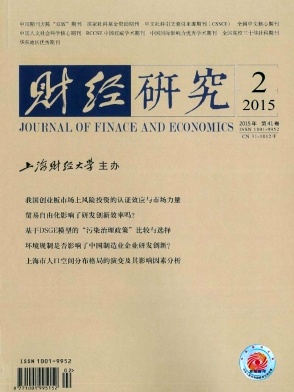城市化进程对能源消费的影响:我们离世界水平还有多远?——基于国内和国际数据的比较考察
财经研究 2015 年 第 41 卷第 02 期, 页码:111 - 122
摘要
参考文献
摘要
加速推进城市化和实现能源总量控制是中国未来经济发展的两大重要任务,但两者之间可能存在矛盾。文章试图通过国际比较的视角来揭示城市化发展对能源消费产生的影响及中国现实。基于62个国家和中国30个省份的混合面板数据,在STIRPAT模型框架下,就国际和国内的城市化对能源消费的影响情况进行了系统的比较考察,并根据实证分析结果对我国2020年的能源消费情况进行了情景分析。研究表明:无论是从国际经验还是从国内现实来看,城市化与能源消费之间均呈现出显著的倒U形关系,这意味着城市化对能源消费的影响随着不同的城市化发展阶段而有所不同;而且,中国的能源消费对城市化的弹性系数要远大于国际水平。情景分析结果表明,中国无法同时实现城市化与能源消费总量控制的双重目标,只能通过调整能源结构的方式来协调这一"两难选择"。
[1]范晓莉.城市化、能源消费与中国经济增长——基于新经济地理视角的动态关系研究[J].西南民族大学学报(人文社会科学版),2014,(1):120-127.
[2]何晓萍,刘希颖,林艳苹.中国城市化进程中的电力需求预测[J].经济研究,2009,(1):118-130.
[3]林伯强,刘希颖.中国城市化阶段的碳排放:影响因素和减排策略[J].经济研究,2010,(8):66-78.
[4]林伯强.中国能源政策思考[M].北京:中国财政经济出版社,2009.
[5]梁朝晖.城市化不同阶段能源消费的影响因素研究[J].上海财经大学学报,2010,(5):89-96.
[6]刘耀彬.中国城市化与能源消费关系的动态计量分析[J].财经研究,2007,(11):72-81.
[7]张晓平.20世纪90年代以来中国能源消费的时空格局及其影响因素[J].中国人口·资源与环境,2005,(2):38-41.
[8]张欢,成金华.中国能源价格变动与居民消费水平的动态效应——基于VAR模型和SVAR模型的检验[J].资源科学,2011,(5):806-813.
[9]周国富,藏超.城市化与能源消费的动态相关性及其传导机制——基于1978年~2008年的实证研究[J].经济经纬,2011,(3):62-66.
[10]麦迪森.世界经济千年统计[M].北京:北京大学出版社,2009.
[11]Anderson C H.The sociology of survival:Social problems of growth[M].Homewood IL:Dorsey Press,1976.
[12]Bell A,Jones K.Explaining fixed effects:Random effects modeling of time-series cross-sectional and panel data[J].Political Science Research and Methods,2014,3(1):133-153.
[13]Breheny M.The compact city and transport energy consumption[J].Transactions of the Institute of British Geographers,1995,20(1):81-101.
[14]Clancy J,Maduka O,Lumampoa F.Sustainable energy systems and the urban poor:Nigeria,Brazil,and the Philippines[A].Hunt T.Urban energy transition:From fossil fuels to renewable power[C].Amsterdam:Oxford University Press,2008.
[15]Clement M T,Schultz J.Political economy,ecological modernization,and energy use:A panel analysis of state-level energy use in the United States,1960-1990[J].Sociological Forum,2011,26(3):581-600.
[16]Ehrhardt-Martinez K,Crenshaw E M,Jenkins J C.Deforestation and the environmental Kuznets curve:A cross-national investigation of intervening mechanisms[J].Social Science Quarterly,2002,83(1):226-243.
[17]Ehrlich P R,Holdren J P.Impact of population growth[J].Science,1971,171(3977):1212-1217.
[18]Ewing R,Rong F.The impact of urban form on U.S.residential energy use[J].Housing Policy Debate,2008,19(1):1-30.
[19]Halicioglu F.The J-Curve dynamics of Turkish bilateral trade:A cointegration approach[J].Journal of Economic Studies,2007,34(2):103-119.
[20]Jones D W.How urbanization affects energy-use in developing countries[J].Energy Policy,1991,19(7):621-630.
[21]Liddle B.Demographic dynamics and per capita environmental impact:Using panel regressions and household decompositions to examine population and transport[J].Population and Environment,2004,26(1):23-39.
[22]Liddle B,Lung S.Age-structure,urbanization,and climate change in developed countries:revisiting STIRPAT for disaggregated population and consumption-related environmental impacts[J].Population and Environment,2010,31(5):317-343.
[23]Madlener R,Alcott B.Energy rebound and economic growth:A review of the main issues and research needs[J].Energy,2009,34(3):370-376.
[24]Mishra V,Smyth R,Sharma S.The energy-GDP nexus:Evidence from a panel of pacific island countries[J].Resource and Energy Economics,2009,31(3):210-220.
[25]Mol A P J.Ecological modernization:Industrial transformations and environmental reform[A].Redclift M,Woodgate G.International Handbook of Environmental Sociology[C].London:Edward Elgar,1997.
[26]Mol A P J.Ecological modernization and the global economy[J].Global Environmental Politics,2002,2(2):92-115.
[27]O’Neill B,Ren X,Jiang L,et al.The effect of urbanization on energy use in India and China in the iPETS model[J].Energy Economics,2012,34(S3):339-345.
[28]Pachauri S.An analysis of cross-sectional variations in total household energy requirements in India using micro survey data[J].Energy Policy,2004,32(15):1723-1735.
[29]Poumanyvong P,Kaneko S.Does urbanization lead to less energy use and lower CO2emissions?A cross-country analysis[J].Ecological Economics,2010,70(2):434-444.
[30]Poumanyvong P,Kaneko S,Dhakal S.Impacts of urbanization on national transport and road energy use:Evidence from low,middle and high income countries[J].Energy Policy,2012,46(C):268-277.
[31]Schnaiberg A.The environment:From surplus to scarcity[M].New York:Oxford University Press,1980.
[32]Wei T.A General equilibrium view of global rebound effects[J].Energy Economics,2010,32(3):661-672.
[33]Wooldridge J M.Introductory econometrics:A modern approach[M].South-Western College Publishing,2012.
[34]York R,Rosa E A,Dietz T.STIRPAT,IPAT and ImPACT:Analytical tools for unpacking the driving forces of environmental impacts[J].Ecological Economics,2003,46(3):351-365.
[35]York R.Demographic trends and energy consumption in European Union Nations,1960-2025[J].Social Science Research,2007,36(3):855-872.
[2]何晓萍,刘希颖,林艳苹.中国城市化进程中的电力需求预测[J].经济研究,2009,(1):118-130.
[3]林伯强,刘希颖.中国城市化阶段的碳排放:影响因素和减排策略[J].经济研究,2010,(8):66-78.
[4]林伯强.中国能源政策思考[M].北京:中国财政经济出版社,2009.
[5]梁朝晖.城市化不同阶段能源消费的影响因素研究[J].上海财经大学学报,2010,(5):89-96.
[6]刘耀彬.中国城市化与能源消费关系的动态计量分析[J].财经研究,2007,(11):72-81.
[7]张晓平.20世纪90年代以来中国能源消费的时空格局及其影响因素[J].中国人口·资源与环境,2005,(2):38-41.
[8]张欢,成金华.中国能源价格变动与居民消费水平的动态效应——基于VAR模型和SVAR模型的检验[J].资源科学,2011,(5):806-813.
[9]周国富,藏超.城市化与能源消费的动态相关性及其传导机制——基于1978年~2008年的实证研究[J].经济经纬,2011,(3):62-66.
[10]麦迪森.世界经济千年统计[M].北京:北京大学出版社,2009.
[11]Anderson C H.The sociology of survival:Social problems of growth[M].Homewood IL:Dorsey Press,1976.
[12]Bell A,Jones K.Explaining fixed effects:Random effects modeling of time-series cross-sectional and panel data[J].Political Science Research and Methods,2014,3(1):133-153.
[13]Breheny M.The compact city and transport energy consumption[J].Transactions of the Institute of British Geographers,1995,20(1):81-101.
[14]Clancy J,Maduka O,Lumampoa F.Sustainable energy systems and the urban poor:Nigeria,Brazil,and the Philippines[A].Hunt T.Urban energy transition:From fossil fuels to renewable power[C].Amsterdam:Oxford University Press,2008.
[15]Clement M T,Schultz J.Political economy,ecological modernization,and energy use:A panel analysis of state-level energy use in the United States,1960-1990[J].Sociological Forum,2011,26(3):581-600.
[16]Ehrhardt-Martinez K,Crenshaw E M,Jenkins J C.Deforestation and the environmental Kuznets curve:A cross-national investigation of intervening mechanisms[J].Social Science Quarterly,2002,83(1):226-243.
[17]Ehrlich P R,Holdren J P.Impact of population growth[J].Science,1971,171(3977):1212-1217.
[18]Ewing R,Rong F.The impact of urban form on U.S.residential energy use[J].Housing Policy Debate,2008,19(1):1-30.
[19]Halicioglu F.The J-Curve dynamics of Turkish bilateral trade:A cointegration approach[J].Journal of Economic Studies,2007,34(2):103-119.
[20]Jones D W.How urbanization affects energy-use in developing countries[J].Energy Policy,1991,19(7):621-630.
[21]Liddle B.Demographic dynamics and per capita environmental impact:Using panel regressions and household decompositions to examine population and transport[J].Population and Environment,2004,26(1):23-39.
[22]Liddle B,Lung S.Age-structure,urbanization,and climate change in developed countries:revisiting STIRPAT for disaggregated population and consumption-related environmental impacts[J].Population and Environment,2010,31(5):317-343.
[23]Madlener R,Alcott B.Energy rebound and economic growth:A review of the main issues and research needs[J].Energy,2009,34(3):370-376.
[24]Mishra V,Smyth R,Sharma S.The energy-GDP nexus:Evidence from a panel of pacific island countries[J].Resource and Energy Economics,2009,31(3):210-220.
[25]Mol A P J.Ecological modernization:Industrial transformations and environmental reform[A].Redclift M,Woodgate G.International Handbook of Environmental Sociology[C].London:Edward Elgar,1997.
[26]Mol A P J.Ecological modernization and the global economy[J].Global Environmental Politics,2002,2(2):92-115.
[27]O’Neill B,Ren X,Jiang L,et al.The effect of urbanization on energy use in India and China in the iPETS model[J].Energy Economics,2012,34(S3):339-345.
[28]Pachauri S.An analysis of cross-sectional variations in total household energy requirements in India using micro survey data[J].Energy Policy,2004,32(15):1723-1735.
[29]Poumanyvong P,Kaneko S.Does urbanization lead to less energy use and lower CO2emissions?A cross-country analysis[J].Ecological Economics,2010,70(2):434-444.
[30]Poumanyvong P,Kaneko S,Dhakal S.Impacts of urbanization on national transport and road energy use:Evidence from low,middle and high income countries[J].Energy Policy,2012,46(C):268-277.
[31]Schnaiberg A.The environment:From surplus to scarcity[M].New York:Oxford University Press,1980.
[32]Wei T.A General equilibrium view of global rebound effects[J].Energy Economics,2010,32(3):661-672.
[33]Wooldridge J M.Introductory econometrics:A modern approach[M].South-Western College Publishing,2012.
[34]York R,Rosa E A,Dietz T.STIRPAT,IPAT and ImPACT:Analytical tools for unpacking the driving forces of environmental impacts[J].Ecological Economics,2003,46(3):351-365.
[35]York R.Demographic trends and energy consumption in European Union Nations,1960-2025[J].Social Science Research,2007,36(3):855-872.
引用本文
刘江华, 邵帅, 姜欣. 城市化进程对能源消费的影响:我们离世界水平还有多远?——基于国内和国际数据的比较考察[J]. 财经研究, 2015, 41(2): 111–122.
导出参考文献,格式为:





 9404
9404  4293
4293

